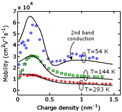
Software
files, programs, and links provided for general interestDownloadable or Executable Programs:
Combined, our contributions hosted on the nanoHub have reached over 27,600 simulation runs, and Prof. Pop's online lectures have served over 47,600 users as of Jan 2024. (Up-to-date usage statistics are here.)

What's the Mobility? (on nanoHub): A simple Excel spreadsheet for quick effective mobility estimates from published I-V transistor data in the linear regime. The user needs to read ID, VT, VGS and VDS from the I-V, plus transistor length, insulator thickness and dielectric constant. The spreadsheet gives the effective mobility, the average charge density, sheet resistance, and a few other things. The user should do sensitivity analysis on RC and VT. Additional tips and an example are given inside the file. If using this, please cite the nanoHUB resource.

Stanford 2D Semiconductor (S2DS) Model (on nanoHub): Simulates 2D transistors and circuits in SPICE. Verilog-A physics-based compact model solves electrical transport coupled with thermal effects, fringe & quantum capacitance, contact resistance, traps & impurities, high-field velocity saturation. A manual is provided at the nanoHUB page with sample circuits and experimental data for comparison. If using this code, please cite Pop Lab publication #118 by S. Suryavanshi & E. Pop, J. Appl. Phys. 120, 011009 (2016).

GFET Tool (on nanoHub): Calculates current-voltage (I-V) curves for graphene transistors, including self-heating and high-field velocity saturation. Versions of this code have been used in Pop Lab publications #34, 40 and 46. Usage instructions are provided on the nanoHUB page. If using this code, please cite Pop Lab publication #46 by M.-H. Bae et al, ACS Nano 5, 7936 (2011).

nanoJoule (on nanoHub): Calculates current-voltage (I-V) curves for metallic single-wall carbon nanotubes, including self-heating and thermal breakdown. Versions of this code have been used in Pop Lab publications #3-5, 12 and 18. A manual is provided on the nanoHUB page. If using this code, please cite Pop Lab publication #12 by E. Pop et al, J. Appl. Phys. 101, 093710 (2007).

CNTmob (on nanoHub): Calculates mobility of semiconducting carbon nanotubes at various charge densities and temperatures. Includes phonon scattering, multiple sub-bands, Pauli blocking, and diameter variation. If using this code, please cite Pop Lab publication #22 by Y. Zhao et al, IEEE Elec. Dev. Lett. 30, 1078 (2009).
 MONET
(local download): Monte
Carlo simulator for bulk and strained silicon, 1- and 2-d devices, and
detailed heat (phonon) generation. This code was used in
Pop Lab publications #1-2, 7-8, 10. The
manual is in Prof. Pop's PhD
thesis. If using this code, please cite #1 or #2 (depending on
application), e.g. E. Pop et al, J.
Appl. Phys. 96, 4998 (2004).
MONET
(local download): Monte
Carlo simulator for bulk and strained silicon, 1- and 2-d devices, and
detailed heat (phonon) generation. This code was used in
Pop Lab publications #1-2, 7-8, 10. The
manual is in Prof. Pop's PhD
thesis. If using this code, please cite #1 or #2 (depending on
application), e.g. E. Pop et al, J.
Appl. Phys. 96, 4998 (2004).
Lab Software Scripts:

Pulsed voltage characterization for the Keithley 26xx instruments: script (written in Lua) and LabView VI. Used for hysteresis-free pulsed mobility measurements on carbon nanotubes, Pop Lab publication by #25 by D. Estrada et al. If using this script, please cite D. Estrada et al, Nanotechnology 21, 085702 (2010).
Matlab Files:
- Custom startup.m file, including code to generate publication-quality figures
- Centered numerical difference function: diffe.m (linear interpolation) and diffes.m (quadratic interpolation)
- Generate better (wider) Matlab error bars: errorbar_widen.m
Matlab Links:
- Tips for making publication-quality Matlab figures
- Calculus with Matlab at UMD
- Solving one-dimensional PDEs with Matlab at Dartmouth
- PDEs with the Matlab pdetoolbox
- Various data fitting resources with Matlab
- For data fitting in Matlab with arbitrary functions use lsqcurvefit
- Interpolation with Matlab (etc) at Minnesota
- Matlab CMOS device models from a UC Berkeley Digital IC book
updated Jan 2023